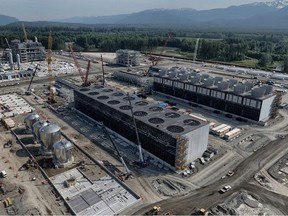Dramatic increases in the cost of TC Energy's Coastal GasLink pipeline highlight the challenges of building LNG infrastructure in B.C., the Institute for Energy Economics and Financial Analysis notes.

Cooling towers and production modules the height of medium-sized, high-rise buildings are rising above LNG Canada’s plant site at Kitimat on the way to a 2025 start for what amounts to Canada’s biggest-ever private-sector investment.
And with the plant’s first phase of two production lines 75-per-cent complete, LNG Canada’s partners are already eyeing the second phase, although with a close eye on costs.
Start your day with a roundup of B.C.-focused news and opinion delivered straight to your inbox at 7 a.m., Monday to Friday.
Thanks for signing up!
A welcome email is on its way. If you don't see it, please check your junk folder.
The next issue of Sunrise presented by Vancouver Sun will soon be in your inbox.
“A Phase 2 final investment decision will take into account several factors, which include overall competitiveness, affordability, pace, future (greenhouse-gas) emissions and stakeholder needs,” said Teresa Waddington, LNG Canada’s vice-president for corporate relations.
Ballooning costs of developing LNG projects in B.C., such as TC Energy’s revelation about its Coastal GasLink pipeline, increase the challenges for proponents and raise doubts about any plans other than those already in play, according to an analyst’s report.
“It’s not like any one cost increase spells the death for the industry,” said Clark Williams-Derry, an analyst with the Institute for Energy Economics and Financial Analysis. “It’s just a matter of sort of weighing headwinds.
“We’re seeing cost increases in the Gulf Coast of the U.S. right now, but just not to the same extent that we are seeing in Canada where it’s just like increases are kind of out of control.”
Last week, TC Energy revealed an updated cost estimate of $14.5 billion for the 670-kilometre pipeline destined to connect LNG Canada to natural gas reserves in B.C.’s Montney shale formation in the province’s northeast around Fort St. John.
That is 30-per-cent higher than the $11.2-billion estimate TC Energy reported last year, which was a 70-per-cent increase from its initial $6.6-billion project estimate.
Williams-Derry said that new $14.5-billion total was a surprise update, which puts his analysis out of date, but highlights the challenges in B.C.
In his analysis, Williams-Derry wrote that mounting pipeline costs would likely lead to higher tariffs for the pipeline’s users, including LNG Canada, and had “eroded LNG Canada’s financial underpinnings.”
For its part, LNG Canada’s Waddington said the company has a contract with TC Energy that “addresses risk allocation,” without adding details on specifics.
And despite outside observations of cost, Waddington said LNG Canada’s advantages include access to plenty of low-cost gas from B.C.’s substantial reserves in the northeast, energy efficiency of liquefaction in the cool environment of northwest B.C., and shorter shipping distance to northern Asia markets.
Williams-Derry said he was skeptical that LNG Canada’s initial phase would go ahead, but was wrong about that.
The analyst acknowledged that at the right commodity prices and with solid contractual commitments, projects will still go ahead.
“Sometimes, high costs don’t matter,” Williams-Derry said.
The LNG Canada project is a consortium of partners led by Shell Canada, which holds a lot of gas reserves in B.C. the project would liquefy, and includes utility firms such as Korea Gas Corp. and Mitsubishi Corp. that have interests in securing gas inventories for their operations.
However, of 14 proposed LNG projects submitted to B.C.’s Environmental Assessment Office in the era of a supposed LNG boom a decade ago, LNG Canada remains the only proposal under construction.
Of the rest, four smaller projects remain on the books, including a modest expansion of FortisBC’s Tilbury LNG plant in Delta, Woodfibre LNG at Squamish, the Haisla First Nation’s small-scale Cedar LNG proposal at Kitimat, and the KSI Lisms LNG partnership of the Nisga’a Nation.
In the meantime, Williams-Derry said the costs to build in B.C. are about double those on the U.S. Gulf Coast, which is in the middle of an actual boom in LNG construction.
“It does look like U.S. markets are a better deal than trying to ship it to the West Coast,” Williams-Derry said.
“Of course, I say this stuff with a full recognition that markets are unpredictable,” he added.
depenner@postmedia.com
twitter.com/derrickpenner


